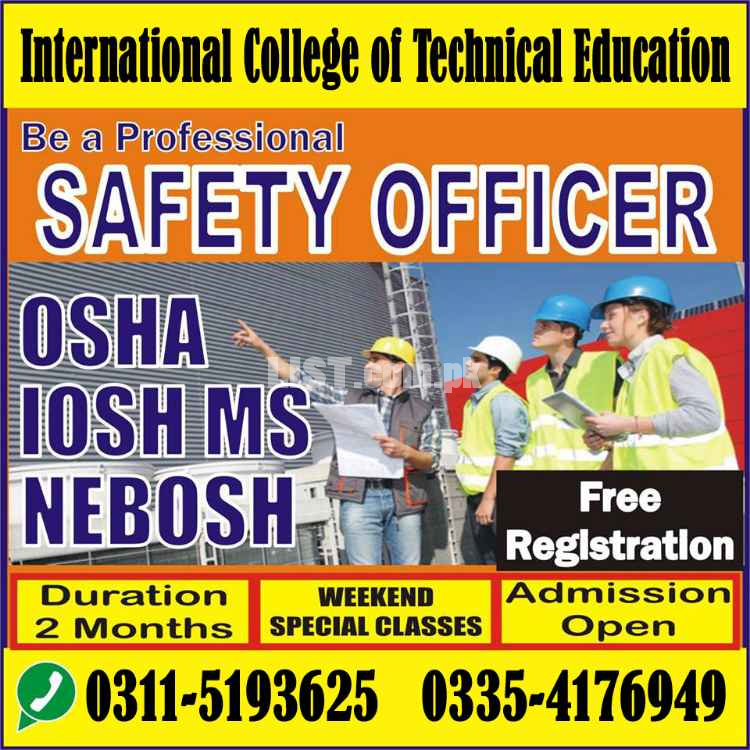IOSH MS COURSE IN TALAGANG
Brand
City
Region
IOSH MS COURSE IN TALAGANG Services in Pakistan
IOSH Managing Safely is a three-day course that gives managers and supervisors the knowledge and skills they need to manage health and safety within their teams.IOSH Managing Safely is a leading health and safety awareness certificate for Managers, Supervisors and Team Leaders. It helps learners understand their health and safety responsibilities and recognise how they can influence, control and monitor risk to improve health and safety in their workplace.
IOSH Managing Safely has 8 learning outcomes. By the end of the course, learners will be able to:
Describe the key reasons to manage safety and health in the workplace.
Define the key terms relating to safety and health.
Identify how the law can have an impact on safety and health in the workplace.
Describe how to assess, reduce and control risk in the workplace.
Identify workplace hazards and risks, their impact and how to manage them.
Identify how to evaluate and respond to an incident.
List the benefits and characteristics of an effective health and safety management system.
Describe the principles that underpin good safety and health performance.
IOSH Managing Safely course syllabus
Module 1: Introducing Managing Safely
The three key moral, legal and financial reasons for managing safely
Manager responsibility and accountability for safety and health in the workplace
Module 2: Assessing Risk
Definitions of the terms ‘hazard’, ‘hazardous event’ and ‘risk’
Definition of the term ‘risk assessment’
Definition of the terms ‘likelihood’ and ‘consequence’
Risk assessment process and risk rating systems
The benefits of carrying out risk assessment
Module 3: Controlling Risk
Definition of the term ‘reasonably practicable’
How to evaluate risk using a risk matrix and how to control those risks
How to reduce risk by applying the ‘hierarchy of risk control’
How implementing risk controls can impact the likelihood of an incident, consequence of an incident or both factors
Definition of the term ‘residual risk’
Module 4: Understanding Managers Responsibilities
An overview of what the law requires an organisation to do to protect the safety and health of workers and other persons under its control
Definition of the term ‘reasonably foreseeable’
The three knowledge tests to help determine ‘reasonably foreseeable’ risks: common, industry and expert knowledge
The difference between criminal law and civil law in relation to safety and health
The possible outcomes of not working within the law
Where to find help and guidance for working within the law
The key parts, and the elements of each part, of a health and safety management system
The key benefits of introducing a health and safety management system
Why leadership is an essential part of a health and safety management system
Module 5: Understanding Hazards
The six main hazard categories and how hazards can fall into more than one group:
Common hazards in the workplace, their effects, and how to manage them: Hazards covered are:
aggression and violence
asbestos
bullying
chemicals
computer workstations
confined spaces
drugs and alcohol
electricity
fire
getting in and out
heights
housekeeping
lighting
manual handling
noise
plant and machinery
radiation
slips and trips
stress
temperature
vehicles and transport
vibration
any other relevant hazards
Module 6: Investigating Accidents
Definition of the terms ‘incident’, ‘accident’ and ‘near miss’
Reasons to investigate incidents
The benefits of incident investigation
Definition of the terms ‘immediate’, ‘underlying’ and ‘root’ causes in relation to incidents
The actions to be taken following an incident
Incident reporting
The stages of a structured approach to incident investigation
Module 7: Measuring Performance
The three essential principles for good safety and health performance
What types of information performance indicators can give to help improve safety and health in the workplace
The characteristics of good key performance indicators
The differences between ‘proactive’ and ‘reactive’ performance indicators
What is meant by ‘auditing’
The two types of auditing: internal and external
Types of evidence used in an audit
IOSH MS COURSE IN TALAGANG services are available in Pakistan at affordable price.
|
|
Education & Classes Services Related Ads

Punjab, Rawalpindi

Punjab, Rawalpindi

Punjab, Rawalpindi

Punjab, Rawalpindi

Punjab, Rawalpindi
- Meet seller at a safe location
- Check the item before you buy
- Pay only after collecting item





Icte
Rawalpindi, Punjab, PakistanPhone No. 03115193625